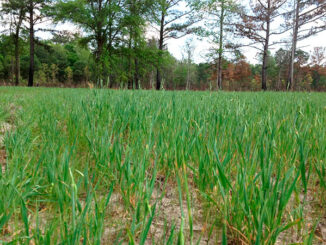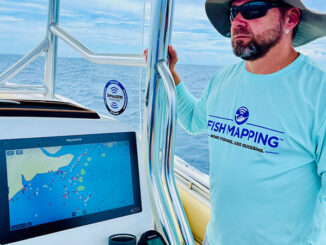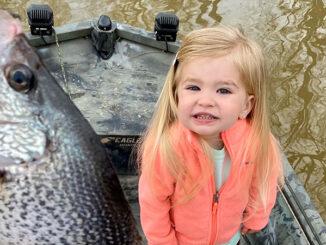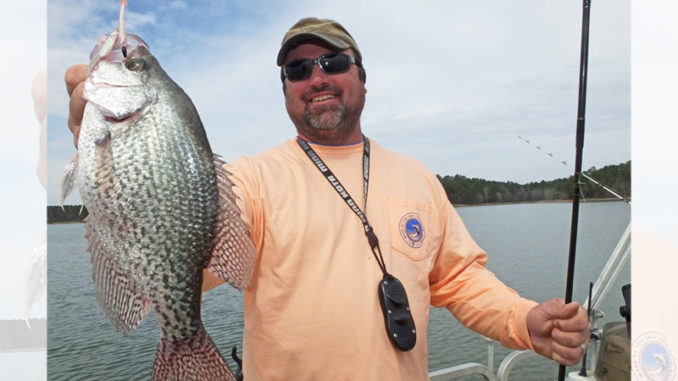
As the spawn approaches on lakes and rivers across North Carolina and South Carolina, a half-dozen reservoirs stand out as hangouts for slabs.
Spring is the peak time of the year for crappie fishing, and the action on the fattest crappie is wide open by March. When roe-laden Carolina slabs make their move toward the shallows, they’re followed by a legion of anglers.
The key to spring success is targeting the right lakes with the appropriate tactics. The ability to adapt to changing weather patterns and tracking the always on-the-move crappie migration from prespawn through post-spawn is crucial.
The Carolinas are full of lakes that are full of crappie. What follows are expert tips on how to fish six of them as March arrives.
Lake Wateree
Crappie fishing pro T.C. Lloyd operates Southern Angling Guide Service. He is familiar with numerous lakes throughout the Carolinas, but among his favorites for spring fishing is Lake Wateree. It’s the last impoundment on the Catawba River system.
“I’ve fished Wateree most of my life, and it’s highly productive,” he said. “The lake has a great population of crappies and produces plenty of slabs this time of the year. But Wateree can be finicky, requiring fishermen to change patterns from one day to the next.”
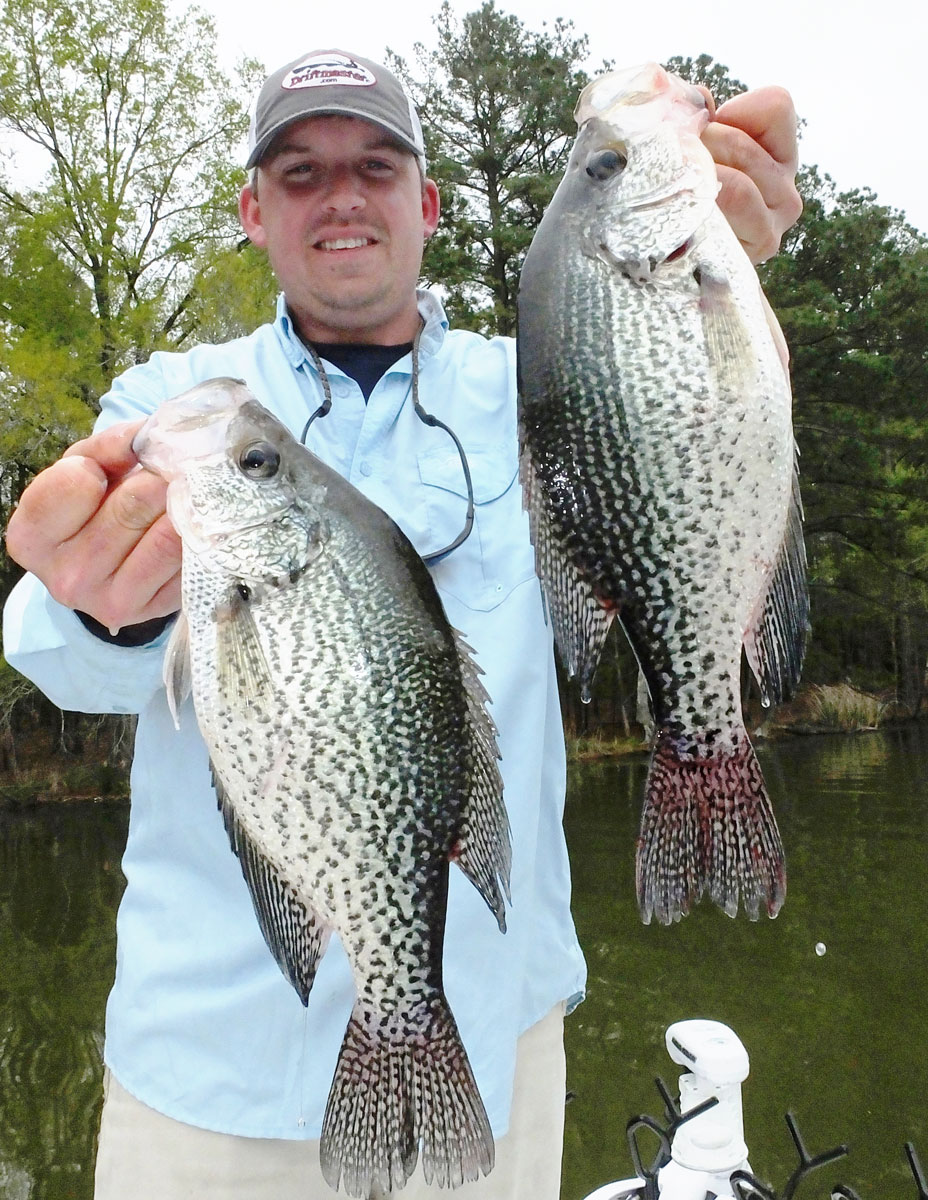
Wateree is among the lakes on which Lloyd, from Hartsville, S.C., guides. He experiments daily with tactics and lures, often opting to begin by long-line trolling. If that doesn’t work, he’s prepared to switch tactics to vertical fishing with tight-lines.
A big variety of colors and sizes will catch Carolina slabs
Lloyd (843-307-6678) uses different-sized jigheads, with 1/48-ounce for checking water that’s shallow in the water column, all the way to 1/8-ounce for deeper water, with 1/32- and 1/16-ounce sizes for mid-depths. He varies motor speed to raise and lower jig depths to refine presentation for the best bite.
“I also use different color combinations, because the amount of sunlight and water color makes a big difference in the best color daily,” he said. “I like a grub with a chartreuse tail. And I will match that with blue, John Deere green, black and junebug color patterns. I’ve had great success with other color patterns, but it’s a good starting point for Lake Wateree.”
Lloyd said he typically targets large creeks from the upper end of the lake at Wateree Creek, all the way to the dam on the lower end. Creeks with dingy, but not muddy, water are prime targets.
He’ll vary his speed from 0.6 up to 1.2 mph based on how deep the crappie are holding. Line size is crucial; he typically uses 4-pound line. And his success proves more slabs are caught with light line.
High Rock Lake
Ed Duke of Concord, N.C., said High Rock Lake on the Yadkin River system is an ideal lake for spring crappie fishing, especially for novice fishermen.
“High Rock rewards fishermen with excellent numbers, with quality crappies mixed in the creel,” Duke said. “Novice anglers can enjoy success. And advanced anglers certainly do well. High Rock is ideal for learning spring crappie-fishing skills while catching plenty of fish.”
Duke, who owns Southern Crappie Rods (704-791-0108), said the length of days and water temperature are keys to spring crappie action. High Rock typically has good water color. So it warms quickly and produces well early in the season.
“As the days get longer, we’ll often find fish staging at the mouths of the creeks, particularly in the upper end of the lake,” he said. “This starts in late-February if water temperatures get warm enough. And dingy water improves the crappie bite.”
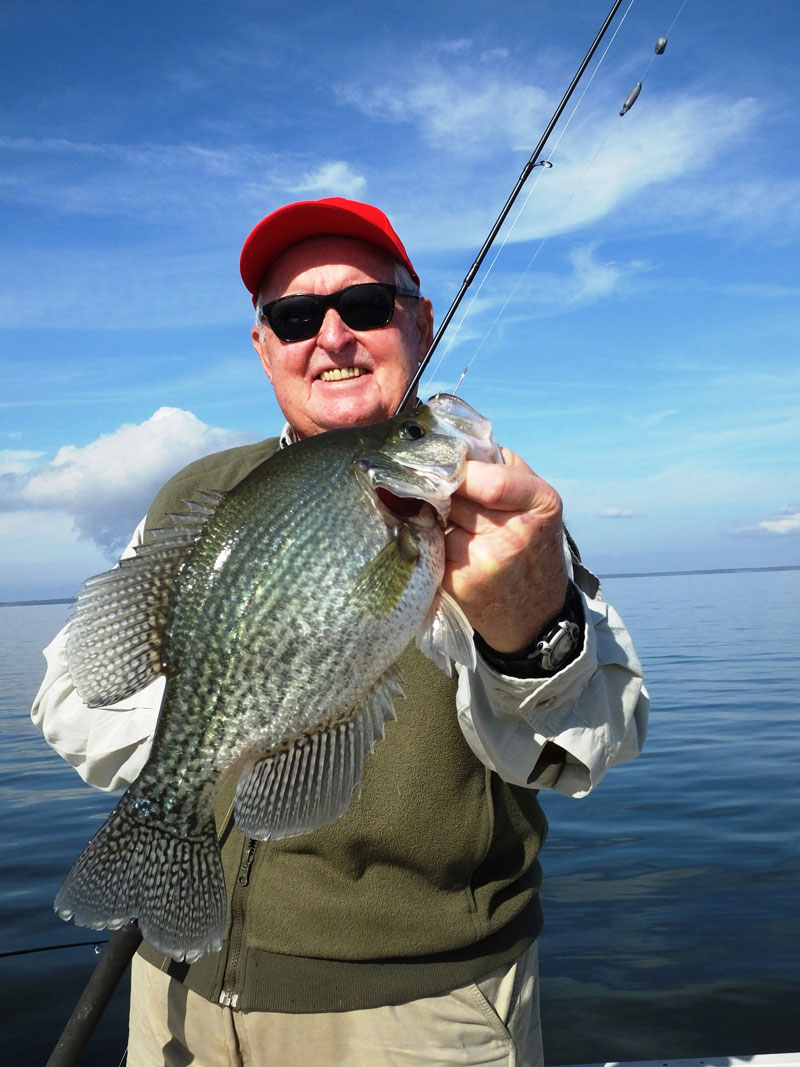
Duke’s basic process is finding crappies staging around creek mouths. And from that point, they’re basically on the way to the back of the creeks to spawn. But not all fish spawn at the same time. So the process of fish moving up the creeks and then back out in post-spawn is an ongoing pattern from late-February until April.
Downsize in shallow water
“The early fish are usually bigger fish,” he said. “Later on, when the bulk of the fish move in to spawn, more fish are present — but fewer slabs — so go early and often.”
Duke said during prespawn, he’ll long-line troll up to a dozen rods in lengths ranging from 7 to 16 feet. He primarily uses very small jigs, with 1/32-ounce a good starting size, but he will use smaller if the fish are really shallow.
“I rely on electronics to see where the fish are daily,” he said. “They may be deep or in mid-depths and occasionally very shallow in the water column.”
Duke said when crappie make their spawning move, he’ll fish in the back of the creeks using a tight-line, spider rig setup. consisting of 8 rods of different lengths to cover as much water as possible.
“Spider-rigging works best when fish get into shallow water . That’s because I can fine-tune bait presentation and keep it at even more precise depths,” he said. “I continue to search until I find where fish are congregated, then focus on that area.”
Santee Cooper
Crappie fishing on the Santee Cooper lakes, Marion and Moultrie, is typically good year-round. But March is a prime time for taking limits of slabs.
Kevin Davis, who guides out of Black’s Camp, said one key to success is adapting to ever-changing water and weather conditions.
Davis (843-312-3080) said fishing can be good in shallow water this month. Some fish hang out around shallow brush, logs, weeds and trees.
“Not all crappies spawn at the same time, and many will be staging deeper. So I’ll often target brush in the 10- to 20-foot depth range,” he said. “With so much prime, shallow-water spawning cover available, it can be difficult to pinpoint hot spots. When guiding, I’ll often target those fat, prespawn fish staging a bit deeper because their locations are more predictable.”
Cypress trees are crappie magnets
“For shallow-water action, I’ll fish the cypress trees, as well as logs, stumps and other woody cover in about 3 to 5 feet of water in Lake Marion,” he said. “In Lake Moultrie, my favored tactic is fishing the back of the coves where slightly deeper depressions exist. I’ll work the woody cover associated with those. That’s where the majority of the super slabs will be spawning on the lower lake. I use a 12-foot pole to poke around the cover and use either jigs, minnows, or a combination of jigs and minnows.”
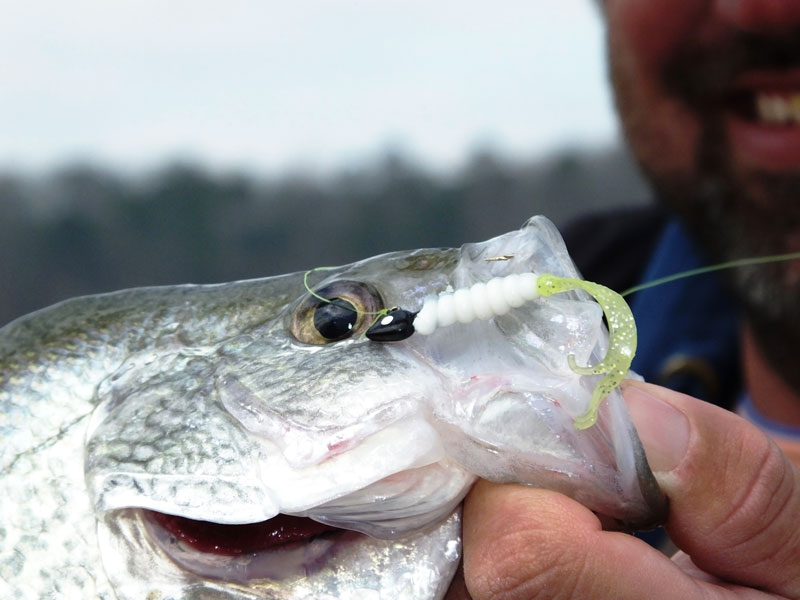
Davis said some anglers also score big catches by long-line trolling on both lakes. His favorite and most-consistent tactic on both lakes is tight-lining brush and cover in 10 to 20 feet of water.
“The fish in 10-foot and slightly deeper depths are usually pre-spawn slabs staging just before moving shallow,” he said. “I use electronics to locate the target, then work the top and sides of the brush before fishing into the cover. I tight-line jigs with minnows or just minnows using split-shots or clip-on weights. Many huge crappie, some over 3 pounds, come from spots like this.”
Davis said that after spawning, the fish return to the same type places.
“This pattern is productive all spring, because we catch them coming and going,” he said.
Kerr Lake
Kerr Lake (Buggs Island) straddles the North Carolina/Virginia border and a reciprocal license agreement is in place. That’s a good option because this 48,900 acre lake has lots of excellent crappie fishing water to explore.
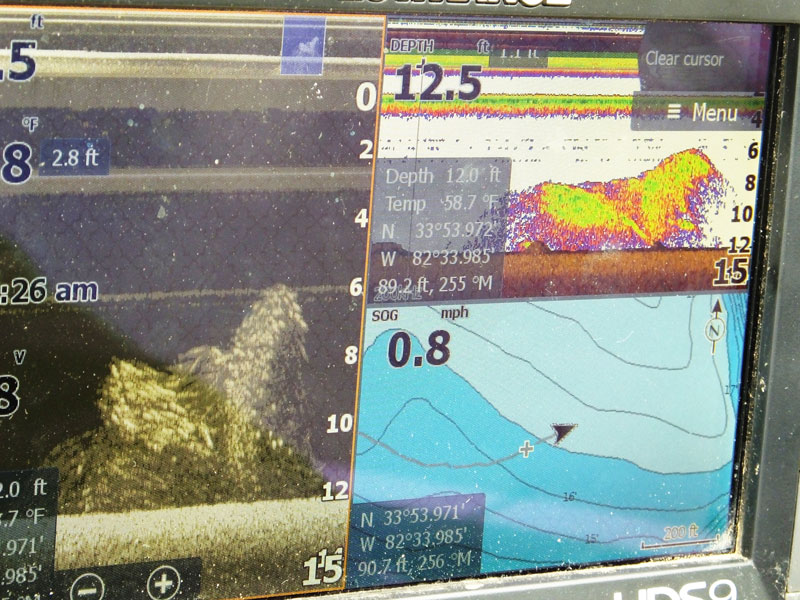
Pete Jordan from Wake Forest, N.C., has fished the entire 49,500-acre lake since he was 16, and his experience makes this lake his ‘go-to’ springtime crappie water.
Jordan owns Ultimate LED Solutions and loves nocturnal crappie fishing later in the year. He said in March, it’s more about covering water and finding patterns.
“I’m usually fishing in February. And when the water temperature reaches 57 degrees, the crappie action begins in earnest,” he said. “I target the very large creeks, as well the feeder creeks further back in the major creeks.”
The shallower, the better at Kerr Lake
Jordan (252-503-0627) said patterns change quickly in March as the water warms. So his first effort is to study his graph before he begins fishing. He searches for fish locations and identifies how deep they’re holding.
“One pattern I hope to see is fish suspended over deeper water,” he said. “These are prespawn fish staging before migrating shallow. My experience has been, the shallower the better, in terms of action. If crappies are in 15 to 20 feet of water, the fishing is usually good. But if fish are in the 7- to 15-foot range, it’s usually much better. Knowing this before I start fishing enables me to place my rigs exactly how I want them from the beginning. I hunt before I actually fish.”
Jordan will long-line troll with 8 rods of different lengths up to 16 feet, enabling him to cover a 32-foot swath of water. He employs his electric motor to keep a 0.5 mph controlled trolling speed.
Lake Shearon Harris
Freddie Sinclair of Clayton, N.C., guides on Shearon Harris, a 4.100-acre lake southwest of Raleigh. He said for the prespawn conditions of March, it’s hard to top Shearon Harris in this part of the state.
“Harris is my ‘go-to’ spring lake because it sets up perfectly for March fishing,” he said. “March is transition time. Warm weather can pull crappies toward the shallows, and then a cold front pushes them deeper again.”
Sinclair said the key is searching for the right pattern and technique based on conditions. Some anglers employ either long-line trolling or vertical tight-lining. But he employs both techniques to find the fish.
“Typically, long-line trolling is best when the crappies are moving into the creeks until they get near the back where they’ll spawn,” he said. “I prefer the tight-line method then, because I can fine-tune my rigging to essentially any depth the fish hold.”
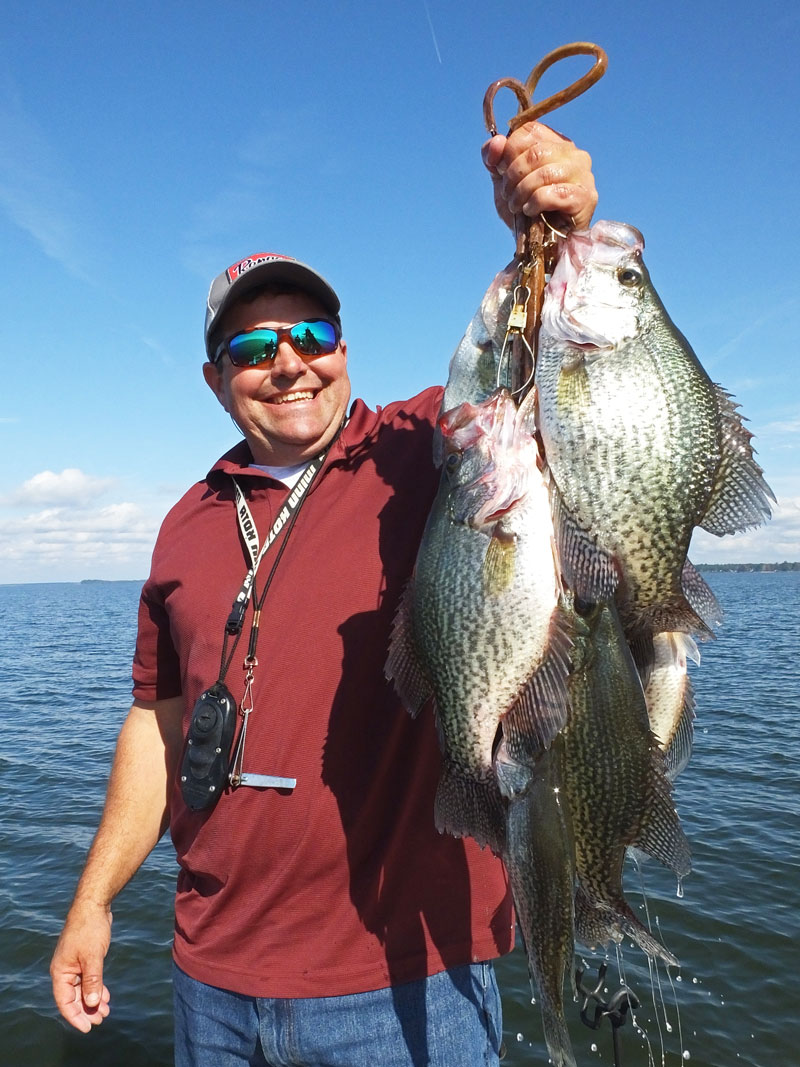
Sinclair (919-553-4547) said for long-line trolling, he’ll generally troll the ledges in the creek or cove pulling as many as 12 rods rigged with 1/48- and 1/32-ounce jigs. He uses curlytails on some rigs and tube or hair jigs tipped with minnows on others, looking for a daily preference.
Chartreuse is always a good color
When crappies get to the back of the creeks, Sinclair switches to tight-line rigs and usually pushes multiple rigs off the front of the boat.
“When spider-rigging, I’ll use 14- and 16-foot rods to get the bait away from the boat, he said. “I’ll use a heavier jig, either a 1/16- or 1/8-ounce, because if the water is calm, that’s all the weight I need. If windy, I’ll use an egg sinker a foot above the jig, with a BB shot just below it.
Sinclair prefers black, red and blue jigs for clear water, with chartreuse grubs and a minnow trailer in clear water. When conditions are dingy to muddy he’ll opt for pink and orange jigs with chartreuse trailers and tipped with minnows.
Sinclair said 2-pound crappie are a reasonable expectation at Harris. But anglers catch a lot of fish in the 8- and 9-inch size classes.
“If this doesn’t produce, I change techniques and begin tightlining with rigs in the front of the boat and fish vertical. I’ll slow my speed to about 0.2 mph,” he said.
Clarks Hill
Guide Chris Simpson targets crappie in March at South Carolina’s Clarks Hill Lake for a very good reason. They can come in limit numbers, and in and huge sizes.
Simpson (864-922-2352) said his personal preference for spring is the upper half of the lake with abundant water in depths where long-line trolling is extremely effective.
“From late February into April, the crappie action is excellent. But where I catch them can change dramatically.” He said. “A great example was in 2018 when, after a week of unusually warm temperatures, the water temperature in the shallows in the back of creeks rose to 68 degrees. The crappies got into 3 to 5 feet of water and bit great. A week later, after normal February temperatures returned, the water temperature dropped to 58 degrees — about normal for that time of year. The fish had moved back much deeper. A totally different pattern was needed.”
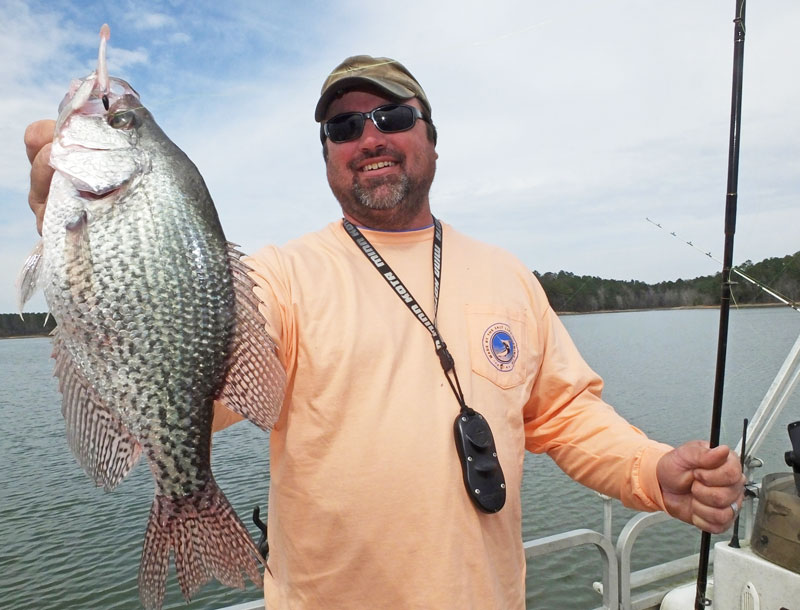
Simpson’s system for March is primarily long-line trolling with a starting speed of about 1.0 mph, varying from 0.7 up to 1.3 mph. He targets ledges and humps in creeks. But he also has a lot of success working points where crappies often congregate.
Mix up styles and color patterns
“If I pick up a single crappie, I usually keep going. But if we hook a double or more in one spot, I’ll work that specific area hard, usually catching a bunch of fish quickly,’ he said. “When action slows, I’m back to searching. But it’s surprising sometimes how quickly the numbers begin to add up.”
Simpson trolls with 6-pound yellow monofilament that enables him to see his lines during tight turns when targeting a specific spot. Jig size will vary, but 1/16-ounce is a good mid-range for Simpson, who fishes jigs with and without minnow trailers.
The best color combinations vary, but Simpson, like many crappie fishermen, often prefers some chartreuse in jig patterns. His idea is to use a darker color body with a chartreuse tail in stained or dingy water. But a solid color, such as pink, red or blue, can be excellent so he mixes grub colors and styles with and without minnow trailers to find the daily preference.

